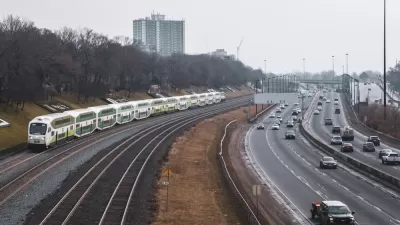Fifteen years in the making, Toronto is finally seeing increased ridership of its main commuter rail system, GO Transit, by changing its model from primarily serving suburban commuters to providing "all-day regional transit service."

Many commuter rail systems focus on delivering suburban workers to their downtown jobs during the morning commute times, and returning them home in the evening along those same corridors. However, most cities' urban fabric are not monocentric, and more commuters are working irregular schedules. These two factors, coupled with a growing population and ripe political climate allowed the regional transit network in Toronto, GO Transit, to increase service.
"GO has spent a decade and a half preparing for this transition, notably by increasing its ownership of track miles on which its trains run from 6% in 1998 to almost 70% today." Yonah Freemark writes. In addition, "more frequent service, potentially on electrified lines, could be coming within 10 years thanks to investments in smaller, lighter vehicles." The latest improvement—bidirectional, 30 minute, all-day service to one suburban commuter line—already raised the line's ridership by 30 percent.
As more cities consider reshaping their transit systems to accommodate growing metropolitan populations, some of Toronto's policies and programs may be helpful to implement or mimic.
FULL STORY: Make the effort, and commuter rail can be as effective as rapid transit

Alabama: Trump Terminates Settlements for Black Communities Harmed By Raw Sewage
Trump deemed the landmark civil rights agreement “illegal DEI and environmental justice policy.”

Study: Maui’s Plan to Convert Vacation Rentals to Long-Term Housing Could Cause Nearly $1 Billion Economic Loss
The plan would reduce visitor accommodation by 25% resulting in 1,900 jobs lost.

Planetizen Federal Action Tracker
A weekly monitor of how Trump’s orders and actions are impacting planners and planning in America.

Wind Energy on the Rise Despite Federal Policy Reversal
The Trump administration is revoking federal support for renewable energy, but demand for new projects continues unabated.

Passengers Flock to Caltrain After Electrification
The new electric trains are running faster and more reliably, leading to strong ridership growth on the Bay Area rail system.

Texas Churches Rally Behind ‘Yes in God’s Back Yard’ Legislation
Religious leaders want the state to reduce zoning regulations to streamline leasing church-owned land to housing developers.
Urban Design for Planners 1: Software Tools
This six-course series explores essential urban design concepts using open source software and equips planners with the tools they need to participate fully in the urban design process.
Planning for Universal Design
Learn the tools for implementing Universal Design in planning regulations.
Caltrans
Smith Gee Studio
Institute for Housing and Urban Development Studies (IHS)
City of Grandview
Harvard GSD Executive Education
Toledo-Lucas County Plan Commissions
Salt Lake City
NYU Wagner Graduate School of Public Service





























